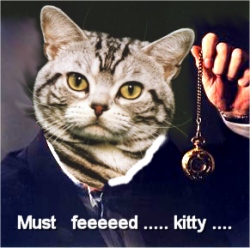The power of purrsuasion

For humans, a cat's purr is normally associated with contentment and well-being. It is soothing both for the cat as the human; and it is a well-documented fact that people who live with a cat suffer less from high blood pressure and heart conditions. Although there is no scientific proof, many suspect that a cat's purr has a lot to do with this piece of good fortune. A cat's purr is a sound like no other in the animal kingdom. It happens when a cat gets emotional (not all purring is a sign of contentment). This emotional trigger sends a reflex from the cat's central nervous system that signals the muscles in its voice box, (the laryngeal muscles) to tighten to the point that they vibrate with air coming in and out of the lungs. For more information about how and why cats purr see: 'The purrsuit of happiness'. Why (and how) cats purr' also on this site. Few sounds signal that all is well with the world as well as the gentle purr of a contented cat.
However, a cat's purr is not always the same sound. Different cats purr differently, and each cat can change its purr in different ways. Cats purr at a sound frequency of between 25 and 150Hz. A very interesting recent study has shown that a hungry cat can alter her purr and mix in an additional 'cry-like' sound. The frequency of this sound is similar to that of a crying baby, and though more subtle, this sound has the same effect on us as the sound of a crying baby. We instinctively want to do something about it, which in this case makes us rush for a tin opener or the kitty treats.
A leading author in this research, Karen McComb, calls this purr/cry combination a 'solicitation purr'. The solicitation purr is at a higher frequency than a contentment purr, and to our ears it sounds more urgent than a normal purr, but not as irritating as a loud 'gimme' meow. Thus a cat that jumps on the bed first thing in the morning and starts purring is more likely to get an early breakfast, while a cat that starts the day with a demanding meow might find itself on the wrong side of a closed bedroom door.
The team of researchers from the Centre for Mammal Vocal Communication Research at the University of Sussex, UK have recorded cats purring when playing with humans and when actively soliciting for food. They then played the sounds back to volunteers (including people who have never owned a cat) to see if they can detect the difference. For most people the solicitation purr sounded more urgent and more unpleasant than the regular purr. But the difference is so subtle that it works on our subconscious. So we react to the purr without being consciously aware of what has caused that reaction. The cats probably use the solicitation purr as a learned response. Cats are excellent at training their humans, and when they find that purring in a particular way gets the required reaction, they take note and try it again in the appropriate situation.
Working with different cats, Karen McComb and her colleagues found that not all cats will use the 'solicitation purr'. A single cat in a quiet household is most likely to use the 'solicitation purr' as a way of asking for food. A cat in a busy and noisy household quickly figures out that the 'solicitation purr' is too subtle and frequently overlooked. So subtlety does not always pay, and when it is loud you have to be even louder, so you put it all into your meow.
If you would like to know more about this study, the team's findings have been published in the the journal Current Biology (Volume 19, Issue 13, R507-R508, 14 July 2009) under the title 'The cry embedded within the purr'. You can also find there supplementary material including samples of the normal and 'solicitation purr' which you can download and judge for yourself.

